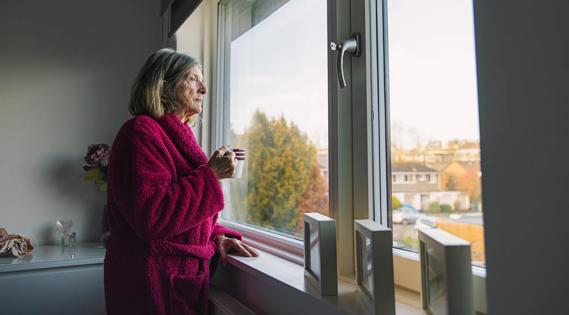Advertisement
Best practices when out and about this autumn

You can still enjoy fall’s signature activities safely during the ongoing coronavirus (COVID-19) pandemic like hayrides, corn mazes and trick-or-treating — if you’re smart and plan ahead.
Advertisement
Cleveland Clinic is a non-profit academic medical center. Advertising on our site helps support our mission. We do not endorse non-Cleveland Clinic products or services. Policy
“There are still plenty of things we can safely do, we just need to take precautions to protect ourselves and those around us, which from time to time, might mean passing on an event or activity if those precautions can’t be followed,” says family medicine specialist Neha Vyas, MD.
Even if you have been vaccinated, keep doing all the things you’ve been doing like maintaining at least six feet from other people, wearing a face mask, using hand sanitizer and practicing hand washing.
And if you haven’t been vaccinated, do it. For those who are 65 or older, and for immunocompromised individuals, it’s important to get the booster shot.
“The more people that get vaccinated, the more we reach herd immunity,” says Dr. Vyas. “We can protect those most vulnerable and eventually if we have enough of a critical mass, we’ll be able to return to our pre-pandemic lives.”
Dr. Vyas shares some insight, advice and modifications for a safe fall.
Parents and kids alike are likely wondering about Halloween this year. But how do you handle trick-or-treating and costumes during a global pandemic?
Whether trick-or-treating will happen this year is up to each community, where officials will look at transmission rates.
Advertisement
“Your city will determine if trick-or-treating is happening or not,” says Dr. Vyas. “If it is, then it’s really about deciding as a family what you’re comfortable with and how you’ll protect yourself and those around you. If your city has determined that trick-or-treating will be canceled, everyone will need to respect that rule as well.”
Parents who allow their kids to trick-or-treat will need to consider quite a few things: How will your child maintain social distance from others? How many houses will they be allowed to visit? How will you help your child keep their hands clean and not touch their face?
And then of course, there’s the concept of incorporating a face mask (and no, we’re not talking a Spiderman mask) into your child’s costume.
Children who are trick-or-treating (and parents who are out with them) will still need to wear a proper face mask, aka it covers the mouth and nose, has multiple layers and ties around the ears or back of the head.
“Get creative and encourage your child to think about how their face mask can be part of their costume,” says Dr. Vyas. “Opt for a mask that matches the costume’s style, or have them pick a costume where a face mask is an essential part — like a doctor or a ninja. And as long as your child can still see and breathe fine and there’s plenty of ventilation, you can layer a Halloween mask over a cloth face mask.”
When you get back home, you might be wondering if you should sanitize your child’s candy haul, but according to Dr. Vyas, it’s not necessary.
“The transmission of coronavirus on surfaces is very low,” she says. “But if you feel safer doing it, then by all means do.”
If you’ve decided that you’re not comfortable with Halloween outside of your direct household (which is perfectly OK!), get creative and have some fun with how you’ll celebrate:
With a little organization, preparation and creativity, it’s possible to still enjoy some of your favorite fall events.
“Make sure that you have more outdoor activities than indoors because the risk of transmission is much lower outdoors,” says Dr. Vyas.
The trick (to this treat) is setting the correct expectation. You’ll also want to keep the golden rules of COVID-19 in mind: Wear a face mask, social distance, don’t touch your face, wash your hands regularly and stay home if you aren’t feeling well.
Here’s what else to keep in mind for several popular fall festivities:
Advertisement
Advertisement
It’s a lesson we’re learned over the last year — if we’re safe, we can still enjoy some activities.
There’s still time to enjoy the great outdoors and local parks this fall, so take a hike and pack a picnic. Enjoy a family car ride to enjoy the fall foliage when the weather turns cool, or hold a faux tailgate in your driveway. Rake leaves, perfect your apple pie recipe or warm up next to a campfire on a crisp night.
“Coronavirus doesn’t have to take all the fun out of everything,” says Dr. Vyas. “If we all practice and respect the safety guidelines, we can slow the spread of the virus and still experience things that bring us joy.”
Advertisement
Learn more about our editorial process.
Advertisement

Studies have shown promising results, but additional research is needed

Infection and inflammation can cause you to lose your voice and have other voice changes until you’re fully healed

A COVID-19 infection can bring on depression or anxiety months after physical symptoms go away

Just like the flu, COVID-19 continues to evolve every year with new and smarter variants

The latest omicron subvariants carry specific mutations that may allow the SARS-CoV-2 virus to be better at evading immune protection

You can work out with mild COVID-19, but not in a gym, and listen to your body and don’t overdo it

Most people can return to work and regular life when they’re symptom-free for 24 hours

Lysol Disinfecting Wipes are just one of more than 500 products approved by the EPA for protection against the SARS-CoV-2 virus that causes COVID-19

If you’re feeling short of breath, sleep can be tough — propping yourself up or sleeping on your side may help

If you fear the unknown or find yourself needing reassurance often, you may identify with this attachment style

If you’re looking to boost your gut health, it’s better to get fiber from whole foods